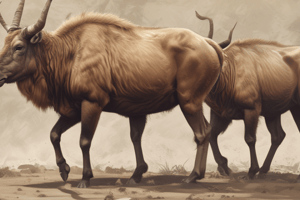Podcast
Questions and Answers
What is a characteristic that distinguishes mammals from other animals?
What is a characteristic that distinguishes mammals from other animals?
- The production of milk to feed young (correct)
- The presence of feathers
- The ability to lay eggs
- The ability to fly
What is the main focus of the study of mammalogy?
What is the main focus of the study of mammalogy?
- The behavior and physiology of mammals (correct)
- The classification of reptiles
- The ecology of aquatic animals
- The evolution of birds
What is a type of mammal that gives birth to underdeveloped young, which then complete development inside a pouch?
What is a type of mammal that gives birth to underdeveloped young, which then complete development inside a pouch?
- Rodent
- Marsupial (correct)
- Monotreme
- Placental
What is an example of a mammalian order that includes lemurs, lorises, and monkeys?
What is an example of a mammalian order that includes lemurs, lorises, and monkeys?
What is the importance of studying mammalian behavior and ecology in agriculture?
What is the importance of studying mammalian behavior and ecology in agriculture?
What is a characteristic of placental mammals?
What is a characteristic of placental mammals?
What is the importance of mammalogy in conservation efforts?
What is the importance of mammalogy in conservation efforts?
What is a characteristic of mammals that is not present in other animals?
What is a characteristic of mammals that is not present in other animals?
What is an example of a mammalian order that includes carnivorous mammals?
What is an example of a mammalian order that includes carnivorous mammals?
What is the importance of studying mammalian physiology in human medicine?
What is the importance of studying mammalian physiology in human medicine?
Study Notes
Mammalogy
Definition and Scope
- Mammalogy is the study of mammals, a class of warm-blooded animals that have hair or fur, and produce milk to feed their young.
- It is a branch of zoology that focuses on the evolution, classification, behavior, physiology, and ecology of mammals.
Characteristics of Mammals
- Warm-bloodedness (endothermy): ability to regulate body temperature internally
- Hair or fur: covering of soft, keratin-based filaments
- Mammary glands: produce milk to feed young
- Three middle ear bones: malleus, incus, and stapes
- Live birth: mammals give birth to live young, as opposed to laying eggs
- Brain development: advanced brain development and complexity
Types of Mammals
- Placentals (Eutheria): give birth to fully formed young, with a placenta providing nourishment
- Examples: humans, primates, carnivores, ungulates
- Marsupials (Metatheria): give birth to underdeveloped young, which then complete development inside a pouch
- Examples: kangaroos, koalas, opossums
- Monotremes (Monotremata): lay eggs, but also produce milk to feed young
- Examples: platypus, echidnas
Mammalian Orders
- Primates: lemurs, lorises, tarsiers, monkeys, apes
- Carnivora: carnivorous mammals, including cats, dogs, bears, weasels
- Ungulata: hoofed mammals, including horses, cows, pigs, deer
- Rodentia: rodents, including mice, rats, squirrels, beavers
- Chiroptera: bats
Importance of Mammalogy
- Conservation: understanding mammalian biology and ecology informs conservation efforts
- Human health: research on mammalian physiology and behavior informs human medicine
- Agriculture: studying mammalian behavior and ecology informs animal husbandry and agriculture
- Environmental monitoring: mammals can serve as indicators of ecosystem health
Studying That Suits You
Use AI to generate personalized quizzes and flashcards to suit your learning preferences.
Description
Test your knowledge of mammals, from their characteristics and types to their importance in conservation, human health, and agriculture. Learn about the different types of mammals, their evolution, and ecology.




